- ABAP Snippets
- Top SAP Courses
- Top SAP Books
SAP and ABAP Free Tutorials

Account assignment in SAP Purchasing (MM) – FAQ

This note provides answers to frequently asked questions regarding account assignment in purchasing documents. This post is based on Snote 496082.
Table of Contents
FAQ: Account Assignement in SAP Purchasing
Account assignement : g/l account for a sales order.
Question: Why is the G/L account for a sales order with nonvaluated individual sales order stock different from the account with valuated indivi dual sales order stock?
Answer: See Note 458270.
Multiple Account Assignment in Purchasing
Question: Can you create several assets at the same time in the new purchasing transactions?
Answer: You can create several assets at the same time. However, you must first ensure that at least as many account assignment lines have bee n created as the number of assets that you want to create. You can do this very easily using the copy function.
G/L Account is not saved if switch to a material group
Question: You create a purchase order with account assignment using transaction ME22. You enter a material group, from which a G/L account is de termined using the valuation class. If you then switch to a material group that does not determine a G/L account via the valuation class, the system deletes the previous G/L account and prompts you to enter a G/L account. If you cancel the account assignment screen and change the material group back on the item detail screen, the previously determined G/L account is not determined again. Why is this ?
Answer: Unfortunately, this system behavior cannot be changed. First, enter any G/L account, so that the item is valid. If you then switch to the old material group again, the system also determines the correct G/L account again.
Entering the same account assignments for different items
Question: Is there an easy way of entering the same account assignments for different items in the new EnjoySAP transactions?
Answer: Ensure that Note 315676 has been implemented in your system and follow the procedure described there
Repeat account assignment function not work in the new EnjoySAP
Question: Why does the repeat acc. assignment function not work in the new EnjoySAP transactions when you create new account assignments in multiple acc. assign. ?
Solution: Use the copy function in multiple acc. assignment to create identical account assignment lines. You can use the repeat account assi gnment function to create similar account assignments for different items with the same account assignment category. To do this, proce ed as described in the answer to question 4.
Issue message KI 161 “Cost center &/& does n ot exist on &
Question: When you change the account assignment of an existing purchase order, why does the system issue message KI 161 “Cost center &/& does n ot exist on &” ? The same phenomenon occurs for other account assignment objects (for example, profit center).
Solution: Refer to Note 193371.
Can you create assets from the single account assignment screen?
Solution: Assets can only be created from the multiple account assignment screen (“Account assignment” tab). You can switch between single account assignment and multiple account assignment on the “Account assignment” tab page by clicking the icon above on the left.
Why does the system not display an account assignment tab page even though you have entered an account assignment category?
Solution: After you have implemented Note 520149, the account assignment tab is not displayed until all the required information is available, for example, the company code.
Why are account assignment objects derived in some situations, even though the relevant field on the account assignment tab page is hidden?
Solution: Refer to Note 619203.
ME 453 “Changing consump. or spec. stock indicator not allowed
You create a purchase order with reference to a subcontracting purchase requisition. This purchase requisition was created with an unknown account assignment, that is, account assignment category “U”. When you change the account assignment category in the purchase order, the system issues error message ME 453 “Changing consump. or spec. stock indicator not allowed (subcontracting)”.
Solution: See Note 205597
Select a valuated goods receipt together with multiple account assignment
Why can you not select a valuated goods receipt together with multiple account assignment in a purchase order or purchase requisition?
Solution: See Note 204252.
EBAN-FISTL, -GEBER, -KBLNR, -GRANT and -FKBER (as in table EKPO) empty
Funds Management is active. Why are the fields EBAN-FISTL, -GEBER, -KBLNR, -GRANT and -FKBER (as in table EKPO) empty? Solution: These fields are only filled if the account assignment category is set to “blank”. If you maintain an account assignment category in t he purchasing document, the system adds the information from these fields to the EBKN table (as in EKKN).
AA 334 “You cannot post to this asset (Asset & & blocked for acquisitions)
You try to change a purchase order item with acc. assignment category “A”, which contains a locked asset. The system issues error message AA 334 “You cannot post to this asset (Asset & & blocked for acquisitions)”. Solution: This is the standard system design. To make changes to this purchase order item, you have the following two options:
a) If you no longer require the purchase order item with the blocked asset, delete the purchase order item. b) Otherwise, you must activate the asset, make the required changes to the purchase order item, and then block the asset again.
The indicator for the account assignment screen
Question: What is the meaning of the indicator for the account assign. screen that you can set in Customizing for single account assignment/m ultiple account assignment? Solution: The indicator determines which account assignment screen is used by default for maintaining the account assign. for a purchase orde r item. For the EnjoySAP transactions, this value is simply a proposal that you can change in the purchasing document. For the old transactions, this value is the only one that you can use.
Question: Is there an unknown account assign. for standard purchase orders?
Solution: This is generally not allowed, and the system issues message ME 069 “Unknown account assignment not defined for use here”. There is an exception in the case of service items that are created with item category D (service) or B (limit).
Acc. Assignment check is not performed when Purchase Order is updated
Question: You change data in a purchase order item (for example, purchase order value, delivery date, and so on). Why does the system not perform another acc. assignment check?
Solution: This is the standard system design. When you created the purchase order item, if the system already checked the acc. assignment and there were no errors, another acc.?assignment check only takes place if you change a field that is relevant to account assign.?(for example, quantity, material number, and so on). If this system response does not meet your requirements, implement the account assignment check in the BAdI ME_PROCESS_PO_CUST. The BA dI is called each time the purchase order is changed.
“In case of account assignment, please enter acc. assignment data for item”
Question: If you delete all the account assign?lines that were entered in the account assignment screen, the system exits the account assign. tab page and goes to the material data. In addition, the system issues the error message “In case of account assignment, please enter acc. assignment data for item”.
Answer: In the current system design, if you delete all the account assignment lines, the system assumes that you do not want to maintain any account assignment data. This conflicts with the account assignment category and the system issues error message 06 436. You can then remove the account assignment indicator. Procedure: If you want to delete all the account assignment data that was entered, see the answer to question 24.
Third-party order processing (CS) and individual purchase order processing (CB)
Question: Which account assignment categories should you enter in schedule line categories for third-party order processing (CS) and individual purchase order processing (CB)? Solution: See Note 210997.
G/L Account is not transfered from Valuation class
Question: In a blanket purchase order or blanket purchase requisition with account assignment, you subsequently change the material group. Even though the new material group is assigned to another G/L account via the valuation class, the system does not redetermine the account assignment for the relevant item. The old G/L account remains.
Solution: See Note 449216.
Customizing Account assignment fields as required entry, optional entry, or display fields
Question: In Customizing, you can set the, or as completely hidden fields, depending on the account assignment category. These settings also determine whether the system deletes or retains the values for the account assignment fields when you change the account assignment category in a purchase order item.
Answer: In Customizing for materials management (MM), when you maintain account assignment categories (IMG: Materials Management-> Purchasing -> Account Assignment-> Maintain Account Assignment Categories), you can control the different account assignment fields as follows: Required entry: You must make an entry in the field, otherwise the system issues error message ME 083.
- Optional entry: Entry in this field is optional.
- Display: The field is displayed, but it is not ready for input.
- Hidden: The field is hidden. Example:
The acc. assignment category is K, the cost center is an optional entry field and it is filled with the value 1000. You change the acc. assignment category to P. Subject to the field settings for the cost center for the acc. assignment category P, the system response is as follows: The cost center is a required entry or an optional entry field: The system transfers the value 1000 for the cos t center.The cost center is a display field: First, the value 1000 for the cost center is deleted. If the system can determine a value again after you enter the changed acc. assignment category, this value is transferred. The cost center is a hidden field: The system deletes the value 1000 for the cost center.
System ignores the acc. assignment data of the purchase requisition for the second schedule line.
Question: You create a purchase order item assigned to an account with reference to a purchase requisition. For this purchase order item, you create a second schedule line with reference to another purchase requisition. The system ignores the acc. assignment data of the purchase requisition for the second schedule line. Solution: This is the standard system design. The system does not generate multiple acc. assignment in the purchase order item, even if the t wo referenced purchase requisitions are assigned to different CO objects. Refer to Note 47150 for the old transactions and to Notes 422609 and 771045 for the EnjoySAP transactions.
Undelete an item in a purchase requisition if assignment data is no longer valid
Question: Why can you undelete an item in a purchase requisition if the corresponding acc. assignment data is no longer valid? Solution: When you undelete an item in a purchase requisition, the system does not perform a new acc. assignment check. Therefore, the accoun t assignment data is not checked again. Nevertheless, errors occur if you try to create a purchase order with reference to this purchase requisition. When you undelete an item in a purchase order, however, the system does perform another acc. assignment check.
Transfer of Acc. Assign. with Reference Document
Question: You create a purchasing document with reference to a reference document. What account assig. data is transferred? Solution: The acc. assignment data is derived from the reference document. If you delete the acc.?assignment category and enter it again, a new automatic general ledger account determination takes place.
Question What is the correct procedure for changing acc. assignment data?
– If, for example, you want to change the acc. assignment category: Note that you MUST first delete all existing acc. assignment data for the relevant item. You can do this by initializing (deleting) the acc. assignment category and confirming by choosing ENTER. Following this, you can enter the new acc. assignment category and the relevant acc. assignment data.
– If you want to change acc. assignment data for the relevant item: For example, you want to change the main acc. assignment objects such as cost center, G/L account, sales order, network, or WBS ele ment, and so on. Here also, we recommend deleting all existing acc. assignment data by initializing (deleting) the account assignme nt category and confirming by choosing ENTER.If you are working with contracts, you must delete the acc. assignment line on the acc. assignment screen and enter a new line t o ensure that the data is derived correctly again. You MUST NOT change the current settings. For example, in some circumstances, the requirements type (OVZH) or the valuation of the requirements class (OVZG) is changed after th e purchasing document is created. This can cause errors in a valuation of goods movements (goods receipt, for example) and MUST BE AVOIDED.
Read more on? Account Assignment
Related Posts

The Most Important SAP Payment Terms Tables (ZTERM, Text…)
October 21, 2018 March 24, 2021

SAP Batch Management: User-exits and BAdIs
June 17, 2017 January 21, 2022

SAP Batch Management Tcodes, Tables and Customizing (SAP Batch Management)
June 16, 2017 January 21, 2022
- Programming
- Admin & EIM
- BI & BW
- FICO & BPC
- CRM & Sales
- Introductions
- SAP PRESS Subscription
Important Item Categories to Know for SAP S/4HANA Sales

Together with sales document types, item categories set the framework for the different business transactions in an SAP S/4HANA system.
The item category allows you to process the same material differently depending on the document type. For instance, if a material is used in a quotation, the item category determined by the system is not relevant for delivery or billing. However, if the same material is entered in a sales order, or a sales order is created with reference to the quotation, a new item category is determined, which makes the item deliverable, and the item can be billed.
The table below shows some of the item categories defined in the standard system for sales documents. If the standard item categories don’t meet the requirements of your project, you can always define your own item categories in customizing to control the sales item differently.

You can define and assign item categories in the IMG menu under Sales and Distribution > Sales > Sales Documents > Sales Document Item . As a reference, the figure below shows a portion of the screen where the standard item category TAN can be configured.
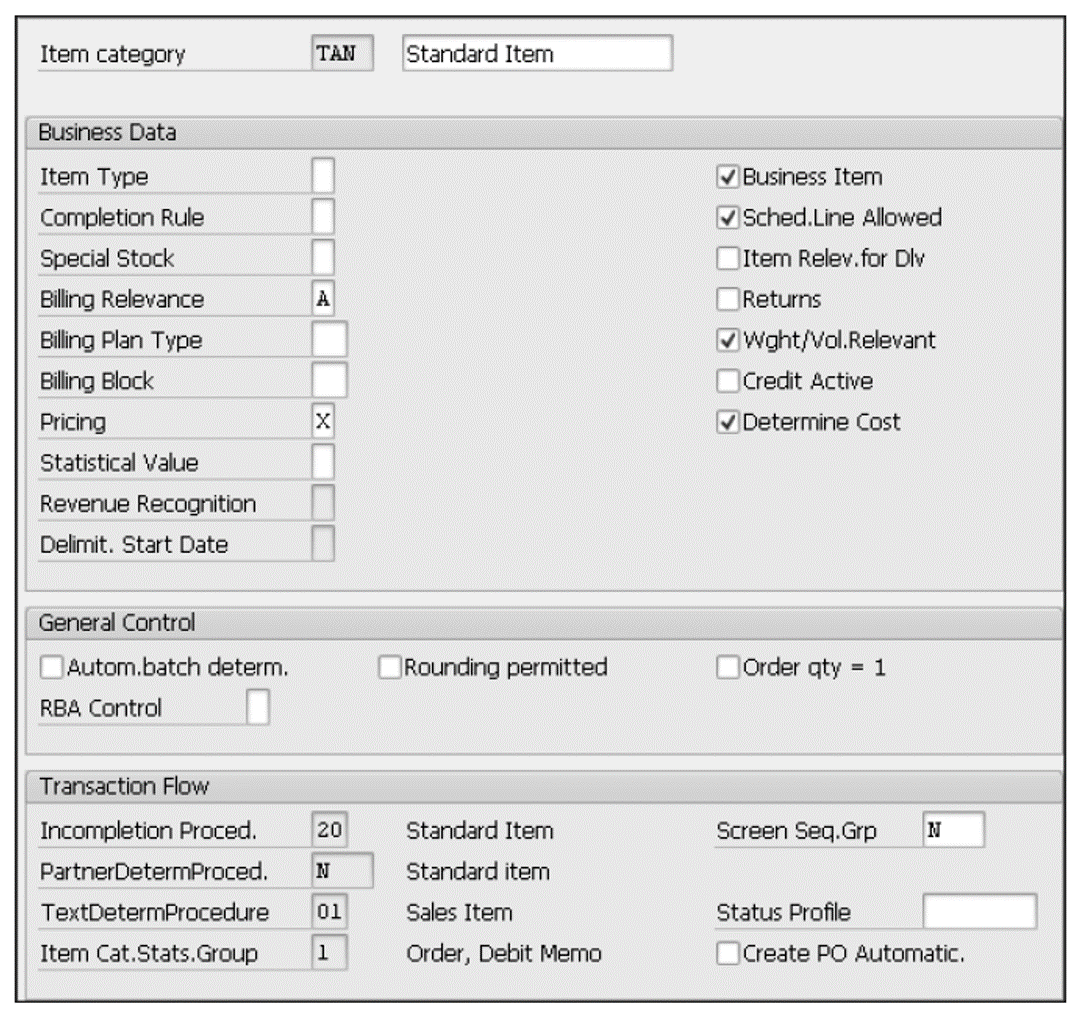
We won’t review every single function controlled by the item category, but you should be aware of the following parameters.
Business Data
For business data, here are the relevant parameters.
This field is used to classify the item so that the system only performs relevant functions. You can specify if the item is a material, text, value item, or packaging. For instance, neither weight calculations nor pricing is carried out for text items.
Completion Rule
This field determines the condition that must be met to mark the item as completed in a sales document. For instance, if value B is selected, the item is marked as completed after the full quantity has been referenced. The completion rule can only be applied if the Update Document Flow field is selected in the copy control (sales document to sales document) at the item level. Some of the values available include the following:
- <blank>: Not relevant for completion.
- A : Item is completed with the first reference.
- B : Item is completed after the full quantity has been referenced.
- C : Item is completed after the target quantity is fully referenced.
This field defines if pricing must be carried out for the item. The following four options are available:
- <blank>: No pricing (e.g., text items)
- X : Pricing standard (e.g., items with price)
- A : Pricing for empties (e.g., returnable packaging such as pallets or crates)
- B : Pricing for free goods (e.g., automatic 100% discount on free of charge items)
Sched.Line Allowed (Schedule Lines Allowed)
If this indicator is selected, schedule lines can be created for the item. You should select this checkbox if the item category is relevant for delivery.
Credit Active
If selected, the item is relevant to be processed by the credit management functions and the value of the item will be updated in the total liability.
Business Item
This field specifies whether business data at the item level can deviate from the values at the header level. For example, if this checkbox is selected, you can enter payment terms 30 days at header level and 60 days at the item level.
Incompletion Proced. (Incompletion Procedure)
This field indicates which fields are part of the incompletion log, that is, which fields must be populated for the item to be completed.
PartnerDetermProced. (Partner Determination Procedure)
The procedure maintained in this field specifies which partner functions are allowed at the item level and which are mandatory.
Create PO Automatic.
If this indicator is selected, the system automatically creates both a purchase requisition and a purchase order (PO) when the sales document is saved for third-party schedule lines.
Structure Scope
This field indicates how a BOM is processed in a sales document. You can specify, for example, whether or not the material structure is exploded and, if so, whether only the first level must be exploded or a multilevel explosion must be carried out.
Shipping Data
Here are the relevant parameters for shipping data.
Item Relev.for Dlv (Item Relevant for Delivery)
If this checkbox is selected, the text or value item is relevant for delivery; thus, the system copies the item into the delivery note. As shown earlier, you don’t need to select this item for standard items that are relevant for delivery (e.g., item category TAN). This field only applies to value or text items (item types A and B, respectively).
Wght/Vol.Relevant (Weight/Volume Relevant)
If selected, the system determines the weight and the volume of the item.
Create Delivery Group
This field determines if the subitems of a BOM that has been exploded in a sales document must be delivered together. The following three options are available:
- <blank>: The system will not form delivery groups, and the BOM components will be delivered as they become available.
- X : The system will use the last date of the items in the group to confirm the schedule line.
- A : The system generates correlated schedule lines. Assuming the Complete Dlv (complete delivery) indicator is not selected, on the first date when something is available (quantity available > 0) for all items in the BOM, a confirmed quantity is calculated based on the ratio of the BOM.
Billing Data
Here are the relevant parameters for billing data.
Billing Relevance
This field specifies whether the item is relevant for billing and, if so, the basis for billing. More than 20 different options are available in this dropdown list. Covering all these options is beyond the scope of this book, but we’ll describe a few of the most common values:
- <blank>: Not relevant for billing.
- A : Delivery-related billing document. The billing for this item is based on the outbound delivery document.
- B : Relevant for order-related billing. The billing for this item is based on the sales document. The billing status in the sales document item is defined according to the order quantity, for instance, item category REN (returns).
- C : Relevant for order-related billing. The billing for this item is based on the sales document. The billing status in the sales document item is defined according to the target quantity, for instance, item category G2N (credit memo).
- D : Relevant for pro forma. This option allows you to make free-of-charge outbound deliveries.
- F : Relevant for order-related billing. The billing for this item is based on the sales document. The billing status in the sales document item and the quantity in the customer invoice are defined according to the invoice receipt quantity. For example, in a third-party sales order scenario, you can specify whether the system must wait for the vendor invoice to be received before an invoice is issued to the customer, for instance, item category TAS (third party business transaction).
- G : Relevant for order-related billing. The billing for this item is based on the sales document and the quantity that has already been delivered. You can bill for multiple partial deliveries in one transaction and one billing document.
- H : Relevant for delivery-related billing. The billing for this item is based on the outbound delivery document. Items with zero quantity are not included in the billing document.
- I : Relevant for order-relevant billing. The billing for this item is based on the sales document. Billing takes place using the billing plan and its status, for instance, item category WVN (maintenance contract).
Determine Cost
If selected, the system determines the cost of the sales document item.
Statistical Value
This field specifies whether the value of the item is used to calculate the total value of the order. The following three options are available:
- <blank>: The system will pass the item value to header totals.
- X : No cumulation. The item value cannot be used statistically.
- Y : No cumulation. The item value can be used statistically.
Billing Block
If a billing block is selected, the system will automatically set the billing block at the item level, so no billing document can be created until the sales document item is reviewed and the billing block removed.
This field indicates whether the item is a return item.
The item category is automatically determined by the system based on the sales document type, the item category group of the material, the higher-level item category, and the usage of the item category. Most of the time, a user won’t need to worry about the item category. However, in some cases, the item category can be changed manually in the sales document item to deviate from the default business transaction.
You can configure the item category determination procedure by assigning item categories to sales document types and item category groups primarily. However, you can also define the usage and higher-level item category when necessary. SAP S/4HANA comes with a list of predefined item category groups covering the most common business scenarios, but you can always define new ones if needed. As shown in this table, we’ve listed some of the main item category groups in the standard system.
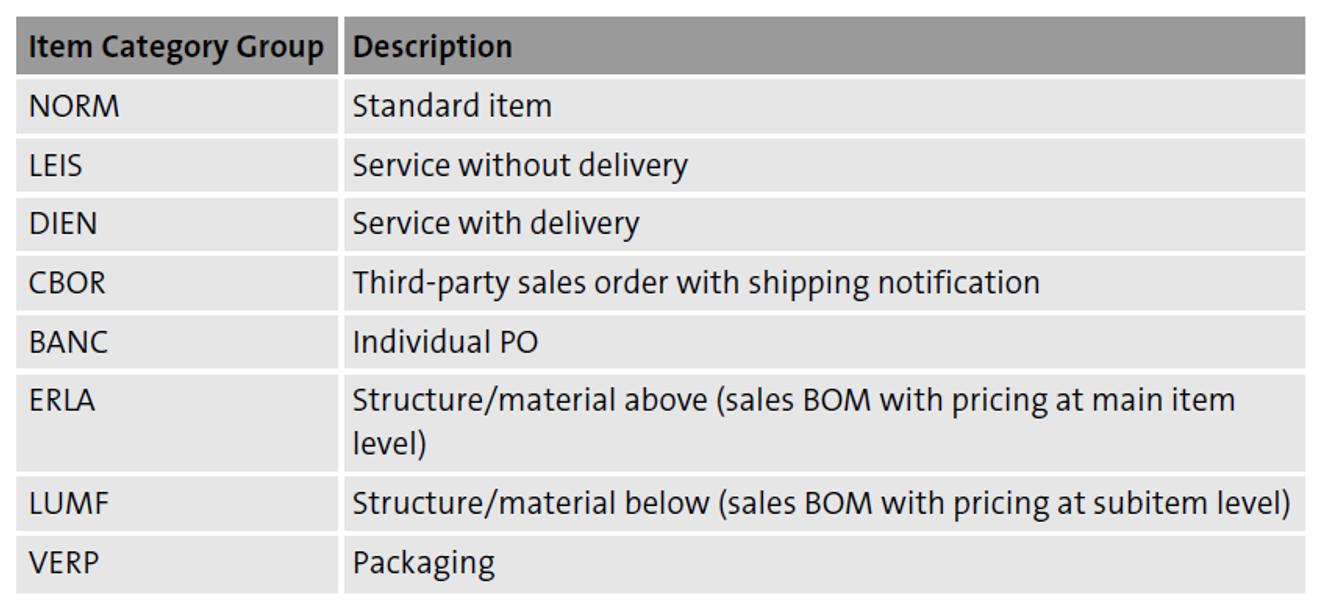
For example, you would normally assign item category group NORM to materials in stock and item category group DIEN to services and nonstock materials that are relevant for delivery.
Tip: Maintaining the correct item category group in the material master record for the relevant sales organizations is vitally important. For each material type, you can define the default item category group, which will be automatically proposed when a material master record is created. This setting helps ensure the expected item category is determined in the sales order item.
The item category usage also contributes to the item category determination and controls the system’s response to special cases, for instance, when the item is the result of a batch split or if the item is a text item. As with the item category group, you can create a new item category usage if the standard offerings don’t meet your requirements. An item category usage is only used in certain circumstances. To illustrate few special circumstances where the item category usage plays a key role in item category determination, this table shows some common values defined in the standard system.
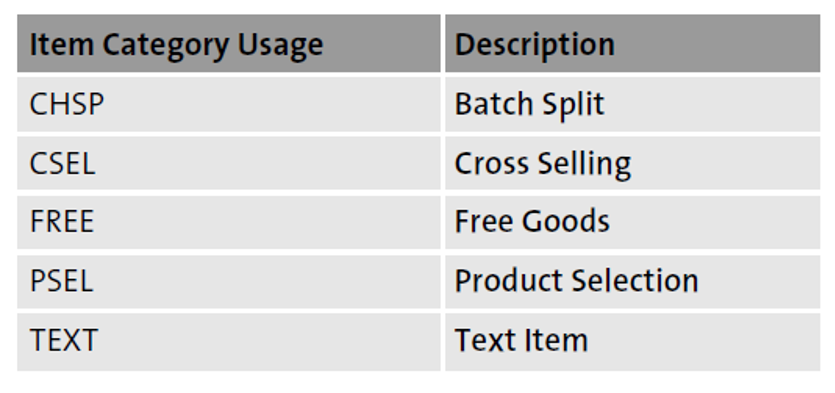
The next step is to assign the default item category and the item categories that can be entered manually to overwrite the value proposed by the system. These alternative item categories are known as manual item categories . The following figure shows the logic to determine the item category in a simple scenario where the sales item contains a material that is neither a subitem nor a special case that utilizes the item category usage.
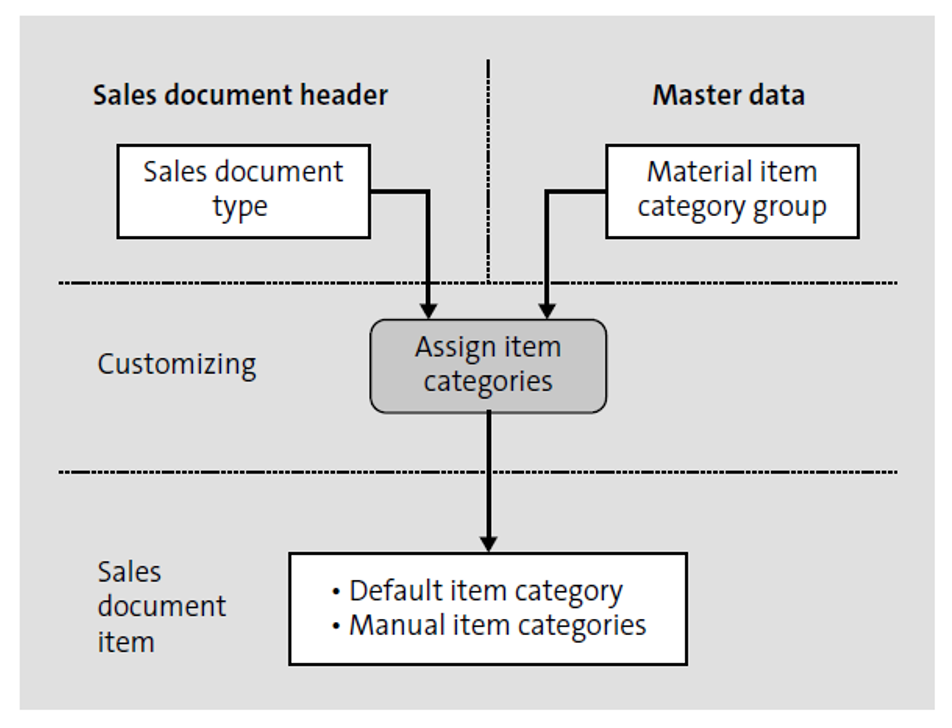
Now that you understand how the system determines the item category in a sales document, let’s take a look at this figure, which shows a subset of the actual customizing table where default and manual item categories are assigned.
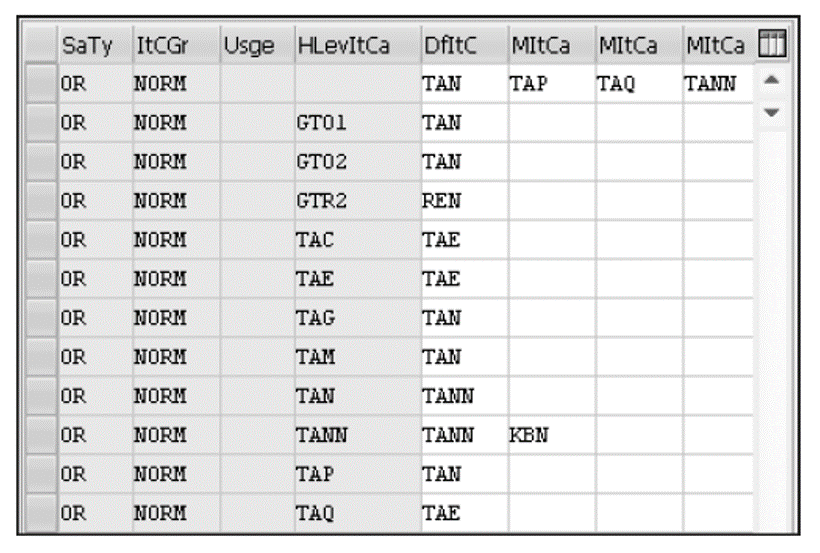
According to the top configuration entry shown, if a material with item category group NORM is entered on a sales document type OR and this material is neither a subitem nor a special case, the system will propose item category TAN, which is the item category maintained in the DfItC (default item category) column, where both the Usge (usage) and HLevItCa (higher-level item category) fields are blank. However, business users have the option to manually change the item category to TAP, TAQ, or TANN. Any other item categories are not allowed in this particular case. You should note that all the other configuration entries shown above are only relevant for subitems, since the HLevItCa column contains the item category of the parent item.
In SAP S/4HANA, you can manually create items in a sales document as subitems or enter a sales BOM, and the system will generate the subitems for you. By definition, a subitem is always allocated to a parent. The item number of the parent can be found in the HL Itm (higher-level item) field of the child (subitem). This table shows an example of a sales document with three items, where items 20 and 30 are subitems of parent item 10.

Assuming the item category group for materials MAT1, MAT2, and MAT3 is NORM, and the sales document type is OR, the example shown aboveis in line with the assignments shown in Figure 4.5. For item 10, the system determines item category TAN (the first entry from the top in the assignment table), whereas item category TANN is proposed for items 20 and 30 (the fourth configuration entry from the bottom).
Another important customizing activity related to item categories allows you to activate enhanced logic to automatically reject sales order items with third-party delivery or individual procurement. If you select the Enhanced Rejection Logic checkbox and enable automatic rejection by selecting an option from the Auto Reject SO Item dropdown list, as shown in the next figure, you can specify an automatic rejection reason for the sales order item that will be automatically applied when either the Delivery Complete or the Final Invoice indicator is set in the corresponding PO item.

You can also select the Update SO Only From Conf. PO checkbox to update the schedule line data of the sales order item only upon confirmation of the corresponding PO item. In the standard system, the schedule data of a sales order item with individual procurement is updated when the delivery date of the related PO item changes. If selected, this indicator would change the standard behavior, and the system will only update the schedule data of a sales order item when the corresponding PO item has been confirmed.
Example: Let’s look at an example of how the automatic rejection functionality works in SAP S/4HANA: You create a sales document using the third-party delivery item category CB1 for 50 units. A PO is generated in the system for 50 units and sent to the vendor.
The vendor has only 45 units available, and there is no plan to manufacture more units as this product has been discontinued. After doing the post goods receipt for 45 units, the buyer sets the Delivery Complete indicator in the PO item.
Assuming both the enhanced rejection logic and the automatic sales order update from PO functionalities have been activated in customizing, as shown earlier, for item category CB1, the system automatically sets the reason for rejection selected on the sales document item. As a result, even though only 45 out of 50 units have been delivered, the sales order item is marked as closed, and it won’t show up in backorder reports.
Note: You can enable automatic rejection and select a reason for rejection only for item categories involving third-party delivery. For example, the automatic rejection works with item category CB1 (third-party delivery), but it cannot be activated for item category TAB (individual procurement).
The functionality to update the sales order item only upon confirmation of the corresponding PO item can be enabled for item categories with third-party delivery or individual procurement.
Editor’s note : This post has been adapted from a section of the book SAP S/4HANA Sales Certification Guide: Application Associate Exam by Darío Franco and Jon Simmonds.
Recommendation
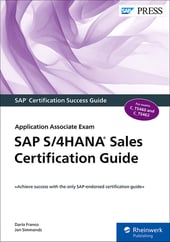
Preparing for your sales or sales upskilling exam? Make the grade with this SAP S/4HANA Sales 1909 and 2020 certification study guide! From availability checks to shipping, this guide will review the key technical and functional knowledge you need to pass the test. Explore test methodology, key concepts for each topic area, and practice questions and answers. Your path to sales certification begins here!
SAP PRESS is the world's leading SAP publisher, with books on ABAP, SAP S/4HANA, SAP CX, intelligent technologies, SAP Business Technology Platform, and more!
Logistics CRM & Sales
Latest Blog Posts

An Overview of Drop Shipping with SAP S/4HANA Sales

ATP Checks in SAP S/4HANA Sales
The official sap press blog.
As the world’s leading SAP publisher, SAP PRESS’ goal is to create resources that will help you accelerate your SAP journey. The SAP PRESS Blog is designed to provide helpful, actionable information on a variety of SAP topics, from SAP ERP to SAP S/4HANA. Explore ABAP, FICO, SAP HANA, and more!
SAP Blog Topics
- Administration
- Business Intelligence
Blog curated by
- Legal Notes
- Privacy Policy
- Terms of Use
- Guest Posting
Account assignment category in sales order Tcode in SAP
- OKB9N Tcode for CO Account Determination Program : Package : KADA Component : SAP_FIN
- OKB9NR Tcode for CO-Account Determination: Rule Maint Program : Package : KADA Component : SAP_FIN
- OCMAC_05C Tcode for Determine Contract Account Category Program : Package : CMAC_E Component : IS-PS-CA
- BEA_ITC_DET Tcode for Determine Item Category Program : Package : BEA_ITC_DET Component : BBPCRM
- COMM_CAT_TEXT_UPG40 Tcode for Convert Category Short Texts (4.0) Program : COM_CATEGORY_TEXT_TRANSL_UCASE Package : COM_CATEGORY Component : SAP_ABA
- CMPRO Tcode for Category Management:Project Mainten. Program : SAPMWCM03 Package : CM_WF Component : SAP_APPL
- S_AX8_68000130 Tcode for Category Management IMG Program : SAPLS_CUS_IMG_ACTIVITY Package : CM_MD Component : SAP_APPL
- S_AX8_68000131 Tcode for Category Management IMG Program : SAPLS_CUS_IMG_ACTIVITY Package : CM_MD Component : SAP_APPL
- OVAK Tcode for Sales Order Type Assignment Program : Package : VS0C Component : BBPCRM
- CRMC_ITEM_CAT_GR Tcode for Item Category Usage Program : Package : CRM_ORDER Component : BBPCRM
- CRMC_IT_TYPE_US Tcode for Item Category Usage Program : Package : CRM_ORDER Component : BBPCRM
- FMFGAPAAC Tcode for Acc. Property account assignment cat Program : Package : FMFG_E Component : EA-PS
- FMSPDERIVE Tcode for Account Distributions derive: steps Program : Package : FM_SPLIT_E Component : EA-PS
- FMSPDERIVER Tcode for Account Distributions derive: values Program : Package : FM_SPLIT_E Component : EA-PS
- OCMAC_06C Tcode for Determine.CO Account Assignment Program : Package : CMAC_E Component : IS-PS-CA
- IAOOMA Tcode for Archiving Release Account Mgmt OM Program : IAOM_OM_SET_ARCHIVALBE_SINGLE Package : IAOM_OM Component : SAP_APPL
- T_SLS_CREATE_SDOC Tcode for Transaction to create a sales doc. Program : R_SLS_CREATE_SDOC Package : ERP_SALES_O2C_SLS Component : SAP_APPL
- MR11 Tcode for GR/IR account maintenance Program : SAPRCKM_MR11 Package : CKMLGRIR Component : SAP_APPL
- MR11SHOW Tcode for Account Maint.Docu.Display-Reversal Program : SAPRCKM_MR11_SHOW Package : CKMLGRIR Component : SAP_APPL
- MR11_OLD Tcode for Old GR/IR account maintenance Program : SAPMM08K Package : CKMLGRIR Component : SAP_APPL
- OVBR Tcode for Assignment to Item Category Program : Package : VIZ Component : BBPCRM
- F9L1 Tcode for Create Posting Category Assignment Program : Package : FKBD Component : EA-FINSERV
- F9L2 Tcode for Change Posting Category Assignment Program : Package : FKBD Component : EA-FINSERV
- F9L3 Tcode for Display Posting Category Assignment Program : Package : FKBD Component : EA-FINSERV
- F9LH Tcode for Create Medium-Category Assignment Program : Package : FKBC Component : EA-FINSERV
- F9LI Tcode for Change Medium-Category Assignment Program : Package : FKBC Component : EA-FINSERV
- F9LJ Tcode for Display Medium-Category Assignment Program : Package : FKBC Component : EA-FINSERV
- WRFCATEGORYSHOP Tcode for Shop/Category Assignment Program : RWRF_CATEGORY_TO_SHOPS Package : WRF_DEPARTMENT_STORE Component : EA-RETAIL
- V_TPR2 Tcode for BP: Assignment Category- Application Program : Package : FTBPOB Component : SAP_ABA
- BBP_CUST_DET_ACCT Tcode for Determine G/L Account by Category Program : Package : BBP_PU_C Component : BBPCRM
- S_AEC_66000049 Tcode for G/L Account for Product Category Program : SAPLS_CUS_IMG_ACTIVITY Package : BBP_CU Component : BBPCRM
- FMFG_PROG_REPT_CODE Tcode for Program Report Category - FACTS II Program : Package : FMFG_E Component : EA-PS
- J-K8 Tcode for IS-M: Order Sales Agent Assignment Program : RMCS4830 Package : JMDGEN_MODIF Component : IS-M
- CRMC_BUS_SUBOB_I Tcode for Assignment BUS-allowed app.area item Program : Package : CRM_ORDER Component : BBPCRM
- CRMC_OBJECT_ASSI Tcode for Assignment Appl. Area - CRM Object Program : Package : CRM_ORDER Component : BBPCRM
- FMFG_SO_HISTORY Tcode for Sales Order History Program : RFFMFG_SO_HISTORY Package : FMFG_E Component : EA-PS
- F9IC Tcode for Create Payment Order Former Account Program : RFBKPO01 Package : FKBO Component : EA-FINSERV
- OVAF Tcode for C SD Tab. 184 Item Category Determ. Program : SAPMSTBM Package : VA0C Component : BBPCRM
- OVAW Tcode for C SD Tab. PTM Item Category Groups Program : Package : VA0C Component : BBPCRM
- VOVO Tcode for Val.period.category Program : Package : VA0C Component : BBPCRM
- OMILL_SE_POSTYP Tcode for Customize Global Item Category Program : Package : MILL_SD Component : ECC-DIMP
- OVXJN Tcode for Sales group -> Sales office Program : Package : VS0C Component : BBPCRM
- OVXMN Tcode for Sales office -> Sales area Program : Package : VS0C Component : BBPCRM
- HB28 Tcode for Sales display "Sales units" Program : SAPMHBSHOM Package : DI_HBS Component : ECC-DIMP
- OVXJ Tcode for Sales group -> Sales office Program : RVOTVBVK Package : VS0CCORE Component : SAP_APPL
- OVXM Tcode for Sales office -> Sales area Program : RVOTVKBZ Package : VS0CCORE Component : SAP_APPL
- DNL_CUST_SALES Tcode for Initial Data Transfer Sales Program : Package : CRM_DATAEXCHANGE_BTX Component : BBPCRM
- KKG3 Tcode for Create Cost of Sales: Sales Order Program : SAPMKKAA Package : KKAG Component : BBPCRM
- V-01 Tcode for Create Sales Order Program : SAPMV45A Package : VA Component : BBPCRM
- VA01 Tcode for Create Sales Order Program : SAPMV45A Package : VA Component : BBPCRM
- VA02 Tcode for Change Sales Order Program : SAPMV45A Package : VA Component : BBPCRM
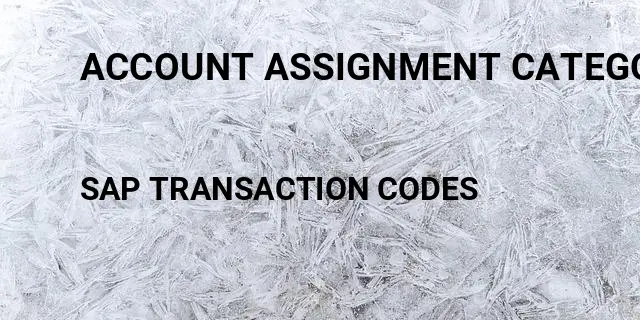
Account assignment category in sales order related terms
Definitions.
SAP is the short form of Systems, Applications & Products in Data Processing. It is one of the largest business process related software. This software focused on business processes on ERP & CRM.
Transaction code shortly known as tcode, is a shortcut code to access different functional areas in SAP. It avoid users from long menu path to reach a report. Instead of that users can type the corresponding transaction code and press enter, the corresponding SAP page will load. It’s a good practice to remember or note down the transaction codes that we need to use in our regular work.
Popular Tcode Searches
Latest tcode searches.

IMAGES
VIDEO
COMMENTS
Account Assignment Category: It indicates what type of purchase the company is doing in Purchasing Documents, whether it is for consumption or anything relation to orders, projects etc. The nature of this also indicates which accounts it needs to be charged for when the incoming invoice and Goods Receipt are posted. Path.
Use. You can assign one or more account assignments to an item. Multiple account assignment allows you to apportion the costs covered by a purchase order partly to your own cost center and partly to others, for example. You specify which account assignment object is to be charged via the account assignment category. Account Assignment Category.
Check the sales order procurement tab. You will find the requirement type. Go to OVZI, check the item category for your sales order. The requirement type is determined by 3 ways as below. ( Source field) Check OVZG how requirement class determines the Account assignment category. Best regards.
The account assignment category indicates whether an item should be assigned to an auxiliary account (such as a cost center) or should be a stock transfer. If the indicator has not been set in the movement type, the movement type cannot be used to generate a reservation. To help you decide which CDS view to use for your purposes, SAP has ...
07-15-20105:16 AM. 0 Kudos. Hiii. Account Assignment object is basically assigned in sales order header/Item tab "Account Assignment" by Assigning WBS element (Project System Object) or Internal order or it derrived from material master General Sales Plant data View as Profit Center (CO object). Regards.
Hi, Account assignment *sales order* is used in PO mostly in case of make to order scenario where MRP run is taken against sales order and in materil master MRP view *Individual requirement is maintained*. In this system will generate the PR with sales order assignment . This is helpful in better costing.
Production order PP module is configured with its all sub modules and production order is already available into the system. Cost Center Relevant cost center with proper assignment is created into the SAP. In addition to the Cost Center, a G/L account number also needs to be available for the purpose. Sales Order S D module is configured with ...
In requirement class 040, account assignment category E is mapped. It has consumption posting "E". SAP recommends Consumption posting E where cost/revenue are to be collected on Sales order item in complex MTO scenario. But we do NOT have a complex MTO scenario, rather it is sales order based mass production.
This internal Order type is used to determine Profit center (present in Account assignmnet tab). As per my knowledge determination of internal order in Sales order is not standard.You can use userexit for determination. However you can also manually add value in that tab. No,it is not not using Sales Order type. Few of internal orders are:-.
Learn how to use the account assignment category in SAP ERP to control the cost object, stock, and account assignment details for different items. Find out how it relates to requirements class, requirement type, and item category.
Solution: The indicator determines which account assignment screen is used by default for maintaining the account assign. for a purchase orde r item. For the EnjoySAP transactions, this value is simply a proposal that you can change in the purchasing document. For the old transactions, this value is the only one that you can use.
Learn how to configure and use account assignment categories in SAP S/4HANA on-premise. This document provides step-by-step instructions for creating, modifying, and deleting account assignment categories, as well as defining the relevant settings for account assignment objects, G/L accounts, and item categories.
The type of account, such as a general ledger account, asset, or cost center, to which costs resulting from the procurement of consumable material are allocated. Account Assignment Category in SAP - Everything you need to know about Account Assignment Category; definition, explanation, tcodes, tables, wiki, relevant SAP documents, PDFs, and ...
In SRM, we perform the customizing of a new account assignment category "E", based on the standard "OS" Sales Order. In SRM SPRO--> Define Account Assignment categories, we assigned two account assignments: SRM = E like ECC = E. However when we generating a Purchase Requisition in ECC and then transfer to SRM, there is created a ...
Account Assignment is the specification of the objects ( for example cost center, sales order, project) that are charged in the case of a purchase order for a material that is intended for direct usage or consumption. A purchase order item can be assigned to a single account or to several accounts. Costs can be distributed on a percentage basis.
Purchase Orders (MM-PUR-PO) Account Assignment; Purchasing (MM-PUR) 6.0 EHP3 SP24. Available Versions: 6.0 EHP8 SP20 ; 6.0 EHP8 SP19 ; ... If you do not have an SAP ID, you can create one for free from the login page. ... Item Category . Purchase Order - Single-Screen Transaction (ME21N, ME22N, and ME23N) ...
In SAP S/4HANA, you can manually create items in a sales document as subitems or enter a sales BOM, and the system will generate the subitems for you. By definition, a subitem is always allocated to a parent. The item number of the parent can be found in the HL Itm (higher-level item) field of the child (subitem).
Can anybody explain how account assignment category is determined. I have created one Sales order and from sales order one Purchase requisition is getting created automatically. that Pur req has a Account assignment category determined automatically. I just want to know how the account assignment category is arrived at.
When double clicking on the WBS Element under the "Account assignment" tab of the sales order item in the "Display Sales Orders - VA03" app, information appears: "You are not authorized to use transaction CJ13". ... Account assignment, Sales order item, Display sales orders, VA03, Not authorized, Transaction, CJ13, Business catalog, SAP_PSP_BC ...
Reproducing the Issue. Set the blocked flag for Purchasing against a WBS Element in Project Control - Enterprise Projects -> Project Planning -> WBS Element. Purchase Requisition or Purchase Order creation is allowed with account assignment containing the above WBS Element where account assignment category is "Q".
Incorrect Account Assignment Category determined. Hello All, As far as I know, the Account assignment category is determined from the "Requirement Class" which in turn is determined from the "Requirement Type". In the Requirement Class, Account assignment category "E" is maintained. But in the Sales Order and subsequent Purchase Order, the ...
A table contains several fields and some of the fields will be key fields. List of Sap sales order account assignment tables in SAP. CRMC_ACC_MAP for Assignment of Account Assignment Group to Account. SMOTVAKZ for Sales Documents: Allowed Order Types per Sales Org.. TJAKT for Sales Order: Texts for Sales Document Types.
List of Account assignment category in sales order transaction codes in SAP. OKB9N for CO Account Determination. OKB9NR for CO-Account Determination: Rule Maint. OCMAC_05C for Determine Contract Account Category. BEA_ITC_DET for Determine Item Category.
T163K. account assignment Categories in Purchasing Document. MM - Purchasing. Transparent Table. 30. TFKCOD. FI-CA: CO account assignment Key/Allocation. FI - Contract Accounts Receivable and Payable. Transparent Table.